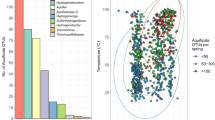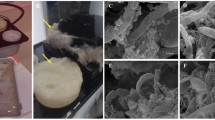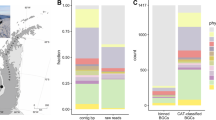Abstract
The genera Exiguobacterium and Psychrobacter have been frequently detected in and isolated from polar permafrost and ice. These two genera have members that can grow at temperatures as low as −5 and −10 °C, respectively. We used quantitative PCR (Q-PCR) to quantify members of these genera in 54 soil or sediment samples from polar, temperate and tropical environments to determine to what extent they are selected by cold environments. These results were further analyzed by multiple linear regression to identify the most relevant environmental factors corresponding to their distribution. Exiguobacterium was detected in all three climatic zones at similar densities, but was patchier in the temperate and tropical samples. Psychrobacter was present in almost all polar samples, was at highest densities in Antarctica sediment samples, but was in very low densities and infrequently detected in temperate and tropical soils. Clone libraries, specific for the 16S rRNA gene for each genus, were constructed from a sample from each climatic region. The clone libraries were analyzed for α and β diversities, as well as for variation in population structure by using analysis of molecular variance. Results confirm that both genera were found in all three climatic zones; however, Psychrobacter populations seemed to be much more diverse than Exiguobacterium in all three climatic zones. Furthermore, Psychrobacter populations from Antarctica are different from those in Michigan and Puerto Rico, which are similar to each other.
Similar content being viewed by others
Log in or create a free account to read this content
Gain free access to this article, as well as selected content from this journal and more on nature.com
or
References
Bakermans C, Ayala-del-Rio HL, Ponder MA, Vishnivetskaya T, Gilichinsky D, Thomashow MF et al. (2006). Psychrobacter cryohalolentis sp. nov. and Psychrobacter arcticus sp. nov., isolated from Siberian permafrost. Int J Syst Evol Microbiol 56: 1285–1291.
Bakermans C, Nealson KH . (2004). Relationship of critical temperature to macromolecular synthesis and growth yield in Psychrobacter cryopegella. J Bacteriol 186: 2340–2345.
Bergholz PW, Bakermans C, Tiedje JM . (2009). Psychrobacter arcticus 273-4 uses resource efficiency and molecular motion adaptations for subzero temperature growth. J Bacteriol 191: 2340–2352.
Bowman JP, Nichols DS, McMeekin TA . (1997). Psychrobacter glacincola sp. nov., a halotolerant, psychrophilic bacterium isolated from Antarctic sea ice. Syst Appl Microbiol 20: 209–215.
Chaturvedi P, Shivaji S . (2006). Exiguobacterium indicum sp. nov., a psychrophilic bacterium from the Hamta glacier of the Himalayan mountain ranges of India. Int J Syst Evol Microbiol 56: 2765–2770.
Cole JR, Chai B, Farris RJ, Wang Q, Kulam SA, McGarrell DM et al. (2005). The Ribosomal Database Project (RDP-II): sequences and tools for high-throughput rRNA analysis. Nucleic Acids Res 33: D294–D296.
Collins MD, Lund BM, Farrow JAE, Schleifer KH . (1983). Chemotaxonomic study of an alkalophilic bacterium, Exiguobacterium Aurantiacum Gen-Nov, Sp-Nov. J Gen Microbiol 129: 2037–2042.
Crapart S, Fardeau M, Cayol J, Thomas P, Sery C, Ollivier B et al. (2007). Exiguobacterium profundum sp. nov., a moderately thermophilic, lactic acid-producing bacterium iolated from a deep-sea hydrothermal vent. Int J Syst Evol Microbiol 57: 287–292.
de Wit R, Bouvier T . (2006). ‘Everything is everywhere, but, the environment selects’; what did Baas Becking and Beijerinck really say? Environ Microbiol 8: 755–758.
Eden PA, Schmidt TM, Blakemore RP, Pace NR . (1991). Phylogenetic analysis of Aquaspirillum magnetotacticum using polymerase chain reaction-amplified 16S rRNA-specific DNA. Int J Syst Bacteriol 41: 324–325.
Excoffier L, Laval G, Schneider S . (2005). Arlequin ver. 3.0: an integrated software package for population genetics data analysis. Evol Bioinform Online 1: 47–50.
Gorbushina AA, Kort R, Schulte A, Lazarus D, Schnetger B, Brumsack HJ et al. (2007). Life in Darwin's dust: intercontinental transport and survival of microbes in the nineteenth century. Environ Microbiol 9: 2911–2922.
Konstantinidis KT, Tiedje JM . (2005). Genomic insights that advance the species definition for prokaryotes. Proc Natl Acad Sci USA 102: 2567–2572.
Kumar S, Tamura K, Nei M . (2004). MEGA3: Integrated software for Molecular Evolutionary Genetics Analysis and sequence alignment. Brief Bioinform 5: 150–163.
Lozupone C, Hamady M, Knight R . (2006). UniFrac--an online tool for comparing microbial community diversity in a phylogenetic context. BMC Bioinformatics 7: 371.
Lozupone C, Knight R . (2005). UniFrac: a new phylogenetic method for comparing microbial communities. Appl Environ Microbiol 71: 8228–8235.
Ludwig W, Strunk O, Westram R, Richter L, Meier H, Yadhukumar et al. (2004). ARB: a software environment for sequence data. Nucleic Acids Res 32: 1363–1371.
Martiny JB, Bohannan BJ, Brown JH, Colwell RK, Fuhrman JA, Green JL et al. (2006). Microbial biogeography: putting microorganisms on the map. Nat Rev Microbiol 4: 102–112.
Papke RT, Ramsing NB, Bateson MM, Ward DM . (2003). Geographical isolation in hot spring cyanobacteria. Environ Microbiol 5: 650–659.
Ponder MA, Gilmour SJ, Bergholz PW, Mindock CA, Hollingsworth R, Thomashow MF et al. (2005). Characterization of potential stress responses in ancient Siberian permafrost psychroactive bacteria. FEMS Microbiol Ecol 53: 103–115.
Rodrigues DF, Goris J, Vishnivetskaya T, Gilichinsky D, Thomashow MF, Tiedje JM . (2006). Characterization of Exiguobacterium isolates from the Siberian permafrost. Description of Exiguobacterium sibiricum sp. nov. Extremophiles 10: 285–294.
Rodrigues DF, Ivanova N, He Z, Huebner M, Zhou J, Tiedje JM . (2008). Architecture of thermal adaptation in an Exiguobacterium sibiricum strain isolated from 3 million year old permafrost: a genome and transcriptome approach. BMC Genomics 9: 547.
Rodrigues DF, Tiedje JM . (2007). Multi-locus real-time PCR for quantitation of bacteria in the environment reveals Exiguobacterium to be prevalent in permafrost. FEMS Microbiol Ecol 59: 489–499.
Romanenko LA, Lysenko AM, Rohde M, Mikhailov VV, Stackebrandt E . (2004). Psychrobacter maritimus sp. nov. and Psychrobacter arenosus sp. nov., isolated from coastal sea ice and sediments of the Sea of Japan. Int J Syst Evol Microbiol 54: 1741–1745.
Schloss PD, Handelsman J . (2005). Introducing DOTUR, a computer program for defining operational taxonomic units and estimating species richness. Appl Environ Microbiol 71: 1501–1506.
Schloss PD, Larget BR, Handelsman J . (2004). Integration of microbial ecology and statistics: a test to compare gene libraries. Appl Environ Microbiol 70: 5485–5492.
Shivaji S, Reddy GS, Suresh K, Gupta P, Chintalapati S, Schumann P et al. (2005). Psychrobacter vallis sp. nov. and Psychrobacter aquaticus sp. nov., from Antarctica. Int J Syst Evol Microbiol 55: 757–762.
Shravage BV, Dayananda KM, Patole MS, Shouche YS . (2007). Molecular microbial diversity of a soil sample and detection of ammonia oxidizers from Cape Evans, Mcmurdo Dry Valley, Antarctica. Microbiol Res 162: 15–25.
Staley JT, Gosink JJ . (1999). Poles apart: biodiversity and biogeography of sea ice bacteria. Annu Rev Microbiol 53: 189–215.
Vela AI, Collins MD, Latre MV, Mateos A, Moreno MA, Hutson R et al. (2003). Psychrobacter pulmonis sp. nov., isolated from the lungs of lambs. Int J Syst Evol Microbiol 53: 415–419.
Vishnivetskaya T, Kathariou S, McGrath J, Gilichinsky D, Tiedje JM . (2000). Low-temperature recovery strategies for the isolation of bacteria from ancient permafrost sediments. Extremophiles 4: 165–173.
Vishnivetskaya TA, Kathariou S . (2005). Putative transposases conserved in Exiguobacterium isolates from ancient Siberian permafrost and from contemporary surface habitats. Appl Environ Microbiol 71: 6954–6962.
Whitaker RJ, Grogan DW, Taylor JW . (2003). Geographic barriers isolate endemic populations of hyperthermophilic archaea. Science 301: 976–978.
White D . (2000). The Physiology and Biochemistry of Prokaryotes, 2nd edn. Oxford University Press: NY.
XLSTAT (2006). XLSTAT. Addinsoft Inc.: Paris.
Yu Y, Breitbart M, McNairnie P, Rohwer F . (2006). FastGroupII: a web-based bioinformatics platform for analyses of large 16S rDNA libraries. BMC Bioinformatics 7: 57.
Yumoto I, Hishinuma-Narisawa M, Hirota K, Shingyo T, Takebe F, Nodasaka Y et al. (2004). Exiguobacterium oxidotolerans sp. nov., a novel alkaliphile exhibiting high catalase activity. Int J Syst Evol Microbiol 54: 2013–2017.
Acknowledgements
This work was supported by a cooperative agreement with NASA Astrobiology Institute number NCC2-1274 and the NSF Long-Term Ecological Research Program at the Kellogg Biological Station. We thank Chia-Ju Lin and Yahira M. Baez for their valuable technical support, Andrew Corbin for providing site access to the Kellogg Biological Station and sampling assistance, Peter Bergholz for the samples from Bratina Island during the 2005–2006 NSF Antarctic Biology Course (OPP Project B-301-M), Dr Fatima Moreira, and the Global Environmental Facility/United Nations Environment Program (GEF/UNEP project CSM-BGBD/GF2715-02 with the global coordination of CIAT/TSBF) for the Brazilian soil samples. We thank the Coordenação de Aperfeiçoamento de Pessoal de Nivel Superior (CAPES) for the financial support to Ederson da Conceição Jesus.
Author information
Authors and Affiliations
Corresponding author
Additional information
Supplementary Information accompanies the paper on The ISME Journal website (http://www.nature.com/ismej)
Supplementary information
Rights and permissions
About this article
Cite this article
Rodrigues, D., da C Jesus, E., Ayala-del-Río, H. et al. Biogeography of two cold-adapted genera: Psychrobacter and Exiguobacterium. ISME J 3, 658–665 (2009). https://doi.org/10.1038/ismej.2009.25
Received:
Revised:
Accepted:
Published:
Issue date:
DOI: https://doi.org/10.1038/ismej.2009.25
Keywords
This article is cited by
-
Detection and description of a novel Psychrobacter glacincola infection in some Red Sea marine fishes in Hurghada, Egypt
BMC Veterinary Research (2023)
-
Bacterial and archaeal community structure in benthic sediments from glacial lakes at the Múlajökull Glacier, central Iceland
Polar Biology (2020)
-
Relationship Between Main Channel Structure of Catalases and the Evolutionary Direction in Cold-Adapted Hydrogen Peroxide-Tolerant Exiguobacteium and Psychrobacter
Indian Journal of Microbiology (2020)
-
Characterization of the prokaryotic diversity through a stratigraphic permafrost core profile from the Qinghai-Tibet Plateau
Extremophiles (2016)
-
Evidence of adaptation, niche separation and microevolution within the genus Polaromonas on Arctic and Antarctic glacial surfaces
Extremophiles (2016)



